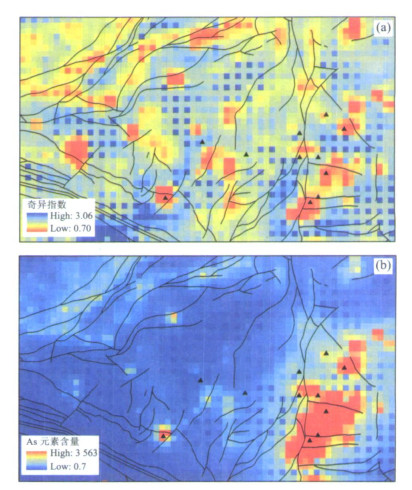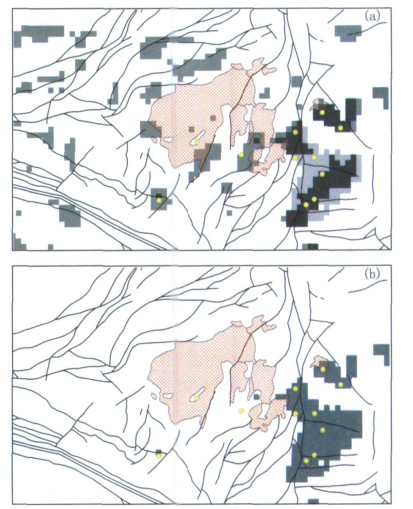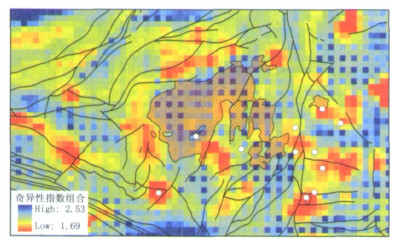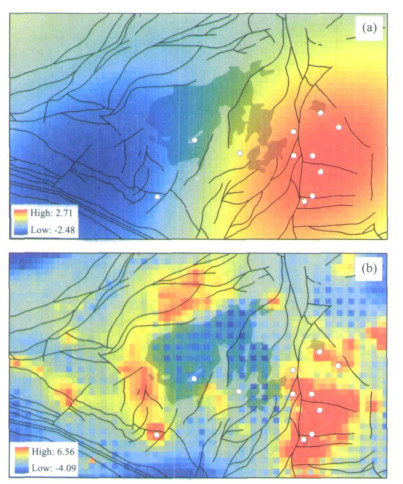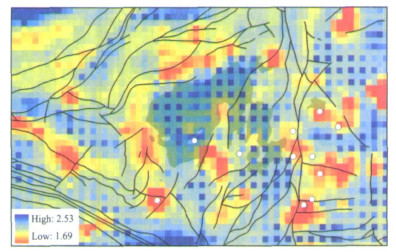Application of Singularity Theory in Prediction of Tin and Copper Mineral Deposits in Gejiu District, Yunnan, China: Weak Information Extraction and Mixing Information Decomposition
-
摘要:
本研究的目的是应用非线性理论和高新信息处理技术获取矿产资源预测综合信息, 开展以有色金属和贵金属矿产资源潜力评价和预测靶区圈定, 提交个旧及周边地区矿产资源潜力分布图.围绕该研究任务, 重点开展了如何应用奇异性理论和方法, 对比个旧东西矿区的异同.由于区域构造和岩体分布等空间变化性, 导致东西区成矿背景存在较大差异, 受出露地表或近地表矿体分布和矿山开采的影响, 东西区的成矿异常强度和大小都存在较大差异, 东区总体呈高背景而西区为低背景, 因而, 对东西区的成矿信息对比研究和异常圈定相对困难.采用局部奇异性分析方法从地球化学分形密度的角度圈定了局部异常, 在东西区均较好地反映了致矿地球化学异常的分布, 同时采用广义自相似分析方法分解了综合地球化学异常和背景.结果表明, 东西区地球化学背景差异悬殊, 而局部异常具有显著的自相似性.据此在东西区同时圈定的局部异常具有内在的相似性和表现形式上的多样性, 以此为依据所圈定的靶区均具有找矿意义.
Abstract:New non-linear theory and methods of multifractal singularity are applied to map weak anomalies related to deeply buried ores and mineralization halos.The main contents of singularity theory and methodology include three main principles and models: local singularity analysis (for example Δ-analysis) for enhancing weak anomalies caused by buried ores, generalized self-similarity analysis (for example C-A and S-A models) for anomaly decomposition and for anomaly and background separation, and fractal spectrum analysis (for example mapping posterior probability) for characterizing spatial distribution of singularities and anomalies.This paper uses the local singularity analysis to map the anomalies not only in the eastern area where known mineral deposits are found but also in the western area where few mineral deposits have been found.It also uses the generalized self-similarity analysis method S-A model in integration of the principle component analysis in separating element association anomalies in both eastern and western areas.The results show that the eastern and western areas depict significant background difference and the local anomalies obtained using both local singularity model and S-A model show generalized self-similarity in eastern and western areas.Several target areas are delineated on the basis of these local anomalies.
-
图 3 (a) As的奇异值(α) 与频数直方图; (b) α阈值与t值的关系
划分不同α阈值, 应用证据权法获取t值, t值大小反映了小于α空间区域与锡矿床的空间相关性(Cheng and Agterberg, 2008)
Fig. 3. (a) Histogram of singularity index of As, (b) relationship between t-value and singularity index value
-
Bonham-Carter, G. F., 1994. Geographic information systems for geoscientists: Modelling with GIS. Pergamon, Oxford, 398. Cheng, Q. M., 1999. Multifractality and spatial statistics. Computer & Geosciences, 25 (9): 949-961. Cheng, Q. M., 2000. GeoData analysis system (GeoDAS) for mineral exploration: User's guide and exercise manual. Material for the training workshop on GeoDAS held at York University, Nov. 1to3, 2000.204. www.gis-world.org/geodat. Cheng, Q. M., 2001. Multifractal and geostatistic metho dsfor characterizinglocal structure and singularity properties of exploration geochemical anomalies. Earth Science—Journal of China University of Geosciences, 26 (2): 161-166 (in Chinese with English abstract). Cheng, Q. M., 2004a. Quantifying the generalized self-similarity of spatial patterns for mineral resources assessment. Earth Science—Journal of China University of Geosciences, 29 (6): 733-744 (in Chinese with English abstract). Cheng, Q. M., 2004b. A new model for quantifying anisotropic scale invariance and for decomposition of mixing patterns. Mathematical Geology, 36 (3): 345-360. doi: 10.1023/B:MATG.0000028441.62108.8a Cheng, Q. M., 2007a. Mapping singularities with stream sediment geochemical data for prediction of undiscovered mineral deposits in Gejiu, Yunnan Province, China. Ore Geology Reviews, 32 (1-2): 314-324. doi: 10.1016/j.oregeorev.2006.10.002 Cheng, Q. M., 2007b. Multifractal imaging filtering and decomposition methods in space, Fourier frequency and Eigen domains. Nonlin. Processes Geophys., 14: 293-303. doi: 10.5194/npg-14-293-2007 Cheng, Q. M., 2007c. Singular mineralization processes and mineral resources quantitative prediction: New theories and methods. Earth Science Frontiers, 14 (5): 42-53 (in Chinese with English abstract). Cheng, Q. M., 2008. Non-linear theory and power-law models for information integration and mineral resources quantitative assessments. Mathematical Geosciences, DOI 10.1007/s11004-008-9172-6. Cheng, Q. M., Agterberg, F. P., 2008. Singularity analysis of ore-mineral and toxic trace elements in stream sediments, Computers & Geosciences, DOI: 10.1016/j.ca-geo.2008.02.034. Cheng, Q. M., Agterberg, F. P., Ballantyne, S. B., 1994. The separation of geochemical anomalies from background by fractal methods. Journal of Geochemical Exploration, 51 (2): 109-130. doi: 10.1016/0375-6742(94)90013-2 Cheng, Q. M., Xu, Y. G., Grunsky, E., 2000. Integrated spatial and spectrum method for geochemical anomaly separation. Natural Resources Research, 9 (1): 43-51. doi: 10.1023/A:1010109829861 Cheng, Q. M., Zhao, P. D., Zhang, S. Y., et al., 2009. Application of singularity theory in prediction of tin and copper mineral deposits in Gejiu district, Yunnan, China: Information integration and delineation of mineral exploration targets. Earth Science—Journal of China University of Geosciences, 34 (2): 243-252 (in Chinese with English abstract). doi: 10.3799/dqkx.2009.022 Lu, Y., 2004. Study on the metallogenic conditions and the ore-hunting prospect for the western district of Gejiu tin mine, Yunnan Province. Bulletin of Mineralogy, Petrology and Geochemistry, 23 (1): 57-61 (in Chinese with English abstract). Qin, D. X., Tan, S. C., Fan, Z. G., et al., 2004. Geotectonic evolution and tin-polymetallic metallogenesis in Gejiu-Dachang area. Acta Mineralogica Sinica, 24 (2): 117-123 (in Chinese with English abstract). Southwestern Metallurgy Exploration Company of the Ministry of Metallurgy Industry, 1984. Geology of Gejiu mineral district. Metallurgy Industry Press, Beijing (in Chinese). Tan, S. C., Qin, D. X., Chen, A. B., et al., 2004. Regional crust evolution and metallogenesis of Gejiu tin deposit—A discussion. Acta Mineralogica Sinica, 24 (2): 157-163 (in Chinese with English abstract). Wan, T. F., 2004. Essentials of tectonics in China. Geological Publishing House, Beijing, 75-271 (in Chinese). Xia, Q. L., Zhang, S. T., Chen, S. Y., et al., 2007. The key problems for deep mineral potential assessment in Gejiu tin deposit, Yunnan, China. Acta Mineralogica Sinica, 27 (Suppl.): 530-531 (in Chinese with English abstract). Xu, Q. D., Xia, Q. L., Cheng, Q. M., 2009. Tectono-magmatic evolution related to metallogenic system in Gejiu ore-concentration area, Southeast Yunnan of China. Earth Science—Journal of China University of Geosciences, 34 (2): 307-313 (in Chinese with English abstract). doi: 10.3799/dqkx.2009.032 Yu, C. W., Tang, Y. J., Shi, P. F., et al., 1988. Dynamic system of Gejiu polymetallic mineralization processes. China University of Geosciences Press, Wuhan, 394 (in Chinese). Zeng, Y. F., Liu, W. J., Chen, H. D., et al., 1995. Evolution of sedi mentation and tectonics of the Youjiang composite basin, South China. Acta Geologica Sinica, 69 (2): 113-124 (in Chinese with English abstract). Zhang, S. T., Xia, Q. L., Zhao, P. D., et al., 2008. Diversity of mineralization and spectrum of the Gejiu superlarge tin-copper polymetallic deposit, Yunnan, China. Journal of China University of Geosciences, 19 (4): 363-370. doi: 10.1016/S1002-0705(08)60069-2 Zhao, P. D., 2002. "Three-component" quantitative resource prediction and assessment: Theory and practice of digital mineral prospecting. Earth Science—Journal of China University of Geosciences, 27 (5): 482-486 (in Chinese with English abstract). Zhao, P. D., Cheng, Q. M., Xia, Q. L., 2008. Quantitative prediction for deep mineral exploration. Journal of China University of Geosciences, 19 (4): 309-318. doi: 10.1016/S1002-0705(08)60063-1 Zhuang, Y. Q., Wang, R. Z., Yang, S. P., et al., 1996. Snand Cu polymetallic mineral deposits in Gejiu. Seismic Pubishing House, Beijing, 124. 成秋明, 2001. 多重分形与地质统计学方法用于勘查地球化学异常空间结构和奇异性分析. 地球科学——中国地质大学学报, 26 (2): 161-166. https://www.cnki.com.cn/Article/CJFDTOTAL-DQKX200102012.htm 成秋明, 2004a. 空间模式的广义自相似性分析与矿产资源评价. 地球科学——中国地质大学学报, 29 (6): 733-744. https://www.cnki.com.cn/Article/CJFDTOTAL-DQKX200406012.htm 成秋明, 2007c. 成矿过程奇异性与矿产预测定量化的新理论与新方法. 地学前缘, 14 (5): 42-53. https://www.cnki.com.cn/Article/CJFDTOTAL-DXQY200705006.htm 成秋明, 赵鹏大, 张生元, 等, 2009. 奇异性理论在个旧锡铜矿产资源预测中的应用: 综合信息集成与靶区圈定. 地球科学——中国地质大学学报, 34 (2): 243-252. https://www.cnki.com.cn/Article/CJFDTOTAL-DQKX200902002.htm 卢耀, 2004. 云南个旧矿区西区成矿条件及找矿远景探讨. 矿物岩石地球化学通报, 23 (1): 57-61. doi: 10.3969/j.issn.1007-2802.2004.01.012 秦德先, 谈树成, 范柱国, 等, 2004. 个旧-大厂地区地质构造演化及锡多金属成矿. 矿物学报, 24 (2): 117-123. doi: 10.3321/j.issn:1000-4734.2004.02.004 谈树成, 秦德先, 陈爱兵, 等, 2004. 个旧锡矿区域地壳演化与成矿探讨. 矿物学报, 24 (2): 157-163. doi: 10.3321/j.issn:1000-4734.2004.02.011 万天丰, 2004. 中国大地构造学纲要. 北京: 地质出版社, 75-271. https://www.cnki.com.cn/Article/CJFDTOTAL-ZQYD2004Z2020.htm 夏庆霖, 张寿庭, 陈守余, 等, 2007. 云南个旧锡矿深部资源潜力评价的几个关键问题. 矿物学报, 27 (增刊): 530-531. 徐启东, 夏庆霖, 成秋明, 2009. 云南个旧矿集区区域构造-岩浆演化与锡铜多金属成矿系统. 地球科学——中国地质大学学报, 34 (2): 307-313. https://www.cnki.com.cn/Article/CJFDTOTAL-DQKX200902013.htm 冶金工业部西南冶金地质勘探公司. 个旧锡矿地质. 北京: 冶金工业出版社, 1984. 於崇文, 唐元骏, 石平方, 等, 1988. 云南个旧锡多金属成矿区内生成矿作用的动力学体系. 武汉: 中国地质大学出版社, 394. 曾允孚, 刘文均, 陈洪德, 等, 1995. 华南右江复合盆地的沉积构造演化. 地质学报, 69 (2): 113-124. https://www.cnki.com.cn/Article/CJFDTOTAL-DZXE199502001.htm 赵鹏大, 2002. "三联式"资源定量预测与评价——数字找矿理论与实践探讨. 地球科学——中国地质大学学报, 27 (5): 482-489. https://www.cnki.com.cn/Article/CJFDTOTAL-DQKX200205001.htm 庄永秋, 王任重, 杨树培, 等, 1996. 云南个旧锡铜多金属矿床. 北京: 地震出版社, 124. -










 下载:
下载:
